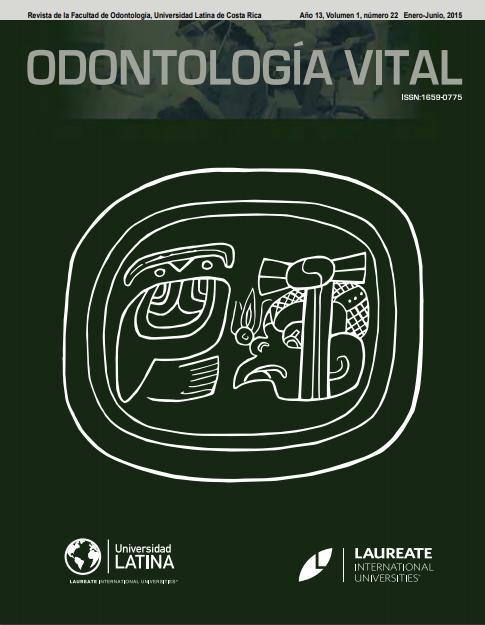Etiology of dental erosive lesions
DOI:
https://doi.org/10.59334/ROV.v1i22.281Keywords:
Dental erosion, injury, chemical dissolution, etiologyAbstract
Dental erosion damage is the chemical dissolution of hard tissues of the tooth produced by the action of acid or chemicals. Currently the etiology of this clinical manifestation has not been fully explained; however, it should be understood as a gradual, cumulative and multi-causal process.
Analysis of etiology and clinical features associated with erosive lesions allows the professional to evaluate treatment alternatives and select the most appropriate. Therefore, in the medical record, the professional should emphasize diet, systemic condition, drug and medicine, occupation, sports and recreational activities associated with the patient, because they can be considered as possible factors associated to the etiology of erosion.
Thus, early identification of these injuries can prevent and correct possible etiologic agents linked to them.
Downloads
References
Abecasis, D., (2001). Desórdenes alimenticios en odontología, anorexia y bulimia nerviosa. Clínica al día.; 10: 266-80.
Asamblea General de la FDI World Dental Federation. Declaración de principios. Ferney Voltaire; 29 de noviembre 2000. Paris: FDI World Dental Federation; 2000.
Bishop, K., Kelleher, M., Briggs, J. R., (1997). Wear now? An update on the etiology of tooth wear. Quintessence Int.; 28(5): 305-313.
Briggs, P., Djemani, S., Chana, H., Kelleber, M., (1998). Young adult patiens with established dental erosion. Rest Dent.: 166-169.
Calatrava, L., (1994). Lesiones del tercio cervical, alternativas de tratamiento. Acta Odontológica Venezolana.; 32(1): 11-18.
Carranza, F., (1998). El envejecimiento y el periodonto. En: Carranza, F., Newman, M., (Eds.), Periodontología Clínica. (8a ed.) (pp.56-60) México: McGraw-Hill Interamericana.
Curtis, J., Farley, B., Goldstein, R.. (2003). Desprendimiento, abrasión, atrición y erosión. En: Goldstein R (Eds.), Odontología Estética. (Vol. 2.) (pp.521-544) Barcelona: STM Editores.
Ganss, C., Schlchtriemen, T., Klimex, D.. (1999). Dental erosion in subjects living on a raw foot diet. Caries Res.; 33(1): 74-80. https://doi.org/10.1159/000016498
Garona, W., (1990). Cervical lesions and dentin hypersensitivity. Caries Res.; 32(1): 22-25.
Goldstein, R., Curtis, J., Farley, B.. (2003). Hábitos bucales. En: Goldstein R (Eds.), Odontología Estética. (Vol. 2). (pp.621-654). Barcelona: STM Editores.
Gómez, M., Campos, A., (2001). Histología y embriología bucodental. (2ª ed.) España: Editorial Panamericana.
Jiménez, G., (2002). Restauraciones estéticas de clase V. En: J Barrancos (Eds.), Operatoria Dental. (3ª ed.) (pp.849-850). Buenos Aires: Editorial Médica Panamericana.
Kasper, H., Braunwald, L., Fauci, J.. (2005). Enfermedades de las vias gastrointestinales. En: Kasper H, Braunwald L, Fauci J (Eds.), Harrison, Principios de Medicina Interna. (16a ed.) (pp.1920-1922). Chile: McGraw Hill.
Kassab, M., Cohen, R., (2002). Treatment of gingival recession. Clinical Practice. J Am Dent Assoc.; 133(11): 1499-1506. https://doi.org/10.14219/jada.archive.2002.0080
Lanata, E., (2005). Restauraciones de Clase V de Black o III de Mount. En: E Lanata (Eds.), Operatoria Dental. Estética y adhesión (pp.137-150). Buenos Aires: Grupo Guía S.A.
Lanata, E., Zaiden, S.. (2005). Preparaciones para el sector anterior. En: E Lanata (Eds.), Operatoria Dental. (pp.117-120). Buenos Aires: Grupo Guía S.A.
Larsen, M., Nivad, B., (1999). Enamel erosion by some soft drinks and orange juices relative to their pH, buffering effect and contents of calcium phosphate. Caries Res.; 33(1): 81-87. https://doi.org/10.1159/000016499
Litonjua, L., Andreana, S., Bush, P., Cohen, R., (2003). Tooth wear: Attrition, erosion, and abrasion. Quintessence Int.; 34(6): 435-43.
Mandel, L., (2005). Dental erosion due to wine consumption. J Am Dent Assoc.; 136(1): 71-5. https://doi.org/10.14219/jada.archive.2005.0029
Meurman, J., Ten, C. H., (1996). Pathogenesis and modifying factors of dental erosion. Eur J Oral.; 104(2): 199-206. https://doi.org/10.1111/j.1600-0722.1996.tb00068.x
Meurman, J., Vesterinen, M.. (2000). Wine, alcohol, and oral health, with special emphasis on dental erosion. Quintessence Int.; 31(10): 729-32.
Saunders, R., Meyerowitz, C., (2005). Dental caries in older adults. Dent Clin of North Am.; 49(2): 293-308.
Schwartz, R., (1999). Restauraciones de clase V. En: Schwartz R, Summit J, Robbins W, (Eds.), Fundamentos en Odontología Operatoria. Un logro contemporáneo. (pp.309-319) Colombia: Editorial Quintessence.
Shaw, L., Smith, J.. (1994). Erosion in children: An increasing clinical problem?. J Am Dent Assoc.; 21: 103-106.
Walsh, T., (2005). Trastornos de la conducta alimentaria. En: Kasper H, Braunwald L, Fauci J,(Eds.), Harrison, Principios de Medicina Interna. (16a ed.) (pp.482-486).Chile: McGraw Hill.
Watson, M., Trevor, F., (2000). Investigation and treatment of patiens with teeth affected by tooth substance loss: a review. Dental Update.; 5(4): 175-81. https://doi.org/10.12968/denu.2000.27.4.175
Wiegand, A., Muller, J., Werner, C., Attint, T.. (2005). Prevalence of erosive tooth wear and associated risk factors in 2-7 year old german kindergarten children. Oral Diseases.; 1: 1-7. https://doi.org/10.1111/j.1601-0825.2005.01167.x
Yip, H., Smales, R., Kaidonis, J.. (2002). Management of tooth tissue loss from erosion. Quintessence Int.; 33(7): 516-520.
Young, W., Khan, F., Shahabi, S., Daley, T.. (1999). Dental cervical lesions associated with oclusal erosion and attrition. Aust Dent J.; 44(3): 176-186.
Downloads
Published
Issue
Section
License
Copyright (c) 2015 Alejandro José Amaíz Flores

This work is licensed under a Creative Commons Attribution 4.0 International License.
Authors who publish with Odontología Vital agree to the following terms:
- Authors retain the copyright and grant Universidad Latina de Costa Rica the right of first publication, with the work simultaneously licensed under a Creative Commons Attribution 4.0 International license (CC BY 4.0) that allows others to share the work with an acknowledgement of the work's authorship and initial publication in this journal.
- Authors are able to enter into separate, additional contractual arrangements for the non-exclusive distribution of the Odontología Vital's published version of the work (e.g., post it to an institutional repository or publish it in a book), with an acknowledgement of its initial publication.
- Authors are permitted and encouraged to post their work online (e.g., in institutional repositories or on their website) prior to and during the submission process, as it can lead to productive exchanges, as well as earlier and greater citation of published work.







